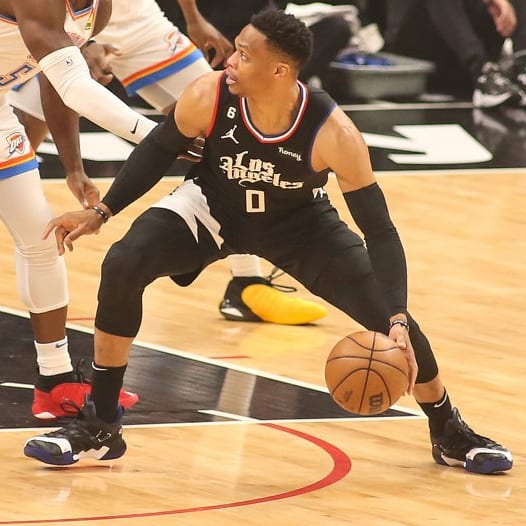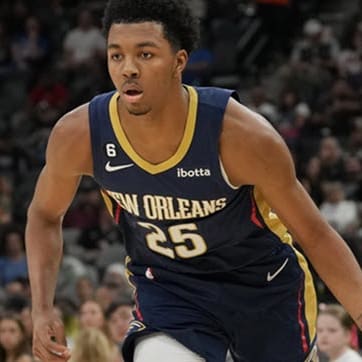This article is part of our DFS Basketball 101 series.
Large-scale guaranteed prize pools (GPPs) in daily fantasy basketball can be just as exhilarating, and potentially lucrative, as those in other major sports. In fact, the overall payouts in NBA-themed tournaments have grown considerably over the last couple of seasons. That said, what are some of the more important strategies to keep in mind while constructing a tournament lineup?
Naturally, some of the popular refrains you may have read previously about tournament strategies in other sports apply for NBA contests as well: look for at least a couple of "boom-or-bust" types who may have a risky floor but a considerable ceiling; seek players who can potentially return at least 5x-6x value on their salaries, at a minimum; stack players from games projected to be the highest-scoring whenever possible; seek to be "contrarian," or against the majority of the field, in at least a couple of spots.
Let's examine these, along with a couple of other points more specific to daily fantasy basketball, a bit further:
Taking Smart Risks
Given that daily fantasy basketball GPPs typically pay out 20 percent of the field or less, you're looking to structure your lineup in a way that will give you a fighting chance to get into that echelon. That means embracing risk, but doing so prudently.
While it's true that you'll have to have some tolerance for rostering a low-floor player or two, opportunity still trumps everything else. The minutes have to be there to make your risk on a low-cost punt play or erratic-but-talented shooter potentially rewarding. Be sure to check on a player's game logs in their RotoWire profile (easily searchable through RotoWire's main NBA page) to see what their recent playing time looks like.
Naturally, injuries create starting opportunities for players all the time, so stay abreast of what reserves have temporarily been elevated to the first unit. And keep in mind that are also always a certain number of scenarios when bench players are regularly receiving enough minutes within their customary roles to generate that 5x-6x return you're looking for in a daily fantasy basketball tournament lineup.
Knowing which positions are best to take flyers on is also helpful. For example, a cost-effective point guard who's sliding into the starting lineup in place of an injured starter can often be a "safer" dart throw than a shooting guard in the same scenario. While the shooting guard might be overly scoring-dependent for a majority of his fantasy production, the point guard, due to their ball-handling responsibilities, is much more likely to accrue fantasy stats in other areas even if their shot is a bit off.
The Importance of Upside and Potential Return
We previously discussed the importance of selecting players who have the ability to offer a significant multiplier on their salary, and that also applies to elite superstars who sometimes seemed priced in the stratosphere, such as $10,000 and higher.
While those prices don't always make it easy to get that level of return, the players typically priced in that range are usually capable of it. Due to natural variance alone, not to mention other factors such as matchup, they won't always get there, but having at least one of these players in your daily fantasy basketball tournament lineup can often be essential to placing in a cashing position. Not only are they often the players with the biggest upside, but on nights when they blow beyond that 5x-6x level, they can even help you make up for the possible shortcomings of another spot in your lineup that may have underperformed.
Using Vegas Odds
As is often the case when constructing lineups for other sports, Las Vegas can serve as a very enlightening guide with respect to which games may offer plenty of fantasy production. Studying the Vegas projected totals for each game, as well as each team's implied total, can immediately help narrow down targets at each position. Projected point totals are particularly important when devising tournament lineups, as your quest for upside essentially mandates that you gravitate toward where the most offense is projected to occur.
That said, it's very prudent to "stack" games projected to be high scoring. Depending on the caliber of players, the degree to which their respective roles are clearly defined and, naturally, salary cap considerations, filling out your tournament lineup with at least two players from each side of a projected high-scoring matchup can pay huge dividends.
Taking this approach a step further, pitting two high-end players who will be matched up against each other can be particularly rewarding. This can especially apply to point guards, which is already a position that tends to offer some of the most consistent fantasy production.
Tips for Being Contrarian in Tournaments
As we emphasized earlier that taking a chance on a player in your tournament lineup is to be done prudently, the same applies when trying to differentiate your lineup at one or two spots. One of the best ways to go against the grain is to take a highly talented player in a perceived difficult matchup.
You'd be surprised at how often even elite players see their ownership percentages in tournaments notably drop when facing one of the top defenses, or a tough one-on-one matchup against a top-level defender. You can often get a serious leg up on the field when you roster such players in these instances, as you're still tapping the same potential upside at potentially a fraction of the player's regular ownership. If his talent transcends the matchup and he offers his typical level of production, you've put yourself at a significant advantage over a large portion of the field at that position.
Another is to "price pivot" to a similarly high upside play. A price pivot simply refers to taking a player who is at the same price or within very close proximity to that of another option that is likely to be much more popular. Granted, factors such as matchup, playing time and the projected point total for that player's team should be evaluated when considering such a move, but when done correctly, it can serve as a highly effective differentiator.
Sources of Research
Knowing where to go for your research when creating a tournament lineup goes hand-in-hand with knowing which strategies to implement. Putting together a tournament lineup that consists of a solid mix of high upside and calculated risk while still sufficiently differentiated can greatly be aided by taking advantage of certain resources. To keep it simple and streamlined, here are two sources that can serve as terrific foundations for creating successful lineups:
• Individual/Team Offense and Defense Rankings: The NBA stat pages on ESPN.com and NBA.com provide full individual and team statistical rankings that offer a thorough perspective on every player in the league, as well as an overall picture of where each team's offensive and defensive units excel and struggle. This can be a great starting point for digging further into the players you may have in mind to either target or exploit, as well to identify potential opportunities that could be flying under the radar.
• Defense vs. Position Rankings: When it comes time to drill down further and examine matchups at a positional level, RotoWire has you covered with that information through the Defense vs. Position page. The information on this page is updated daily, and there are even specific breakdowns for three major DFS operators (DraftKings, FanDuel, FantasyAces) of the average fantasy points allowed by each team to each position over the season, last five games and last 10 games.
Defense vs. position trends often hold true in the NBA for the length of a season. For example, some teams simply have a lack of size up front that can't really be addressed effectively in-season. Therefore, they're very likely to struggle against centers and power forwards almost every night, making them a potential team to exploit with bigs.
One way to refine this research even further is by knowing the particular skill sets of different players and looking at the defense vs. position data to maximize your selection. For example, when looking at the rankings on the aforementioned RotoWire page, you'll note that there is a breakdown that includes average number of blocks, steals, three-pointers, etc. given up to each position by team.
Say you've identified two strong candidates that you like at point guard and have only one remaining lineup slot in that position to fill. Both guys are up against teams that are about as weak as the other, but you take note that one of the opposing defenses allows plenty of three-pointers to point guards. If the player you're considering is proficient from long rang, that could be your tie-breaker, as that piece of data helps you maximize your potential upside.












